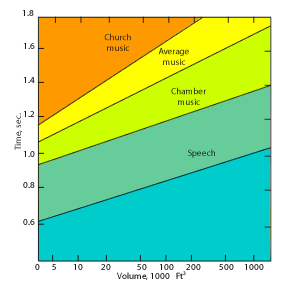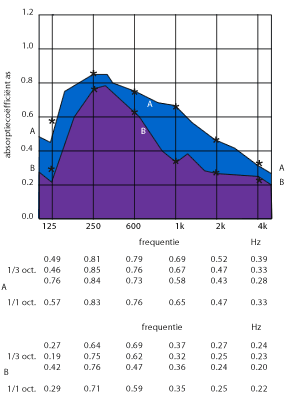Demands on acoustics in spaces
The movement of sound from a source to a listener is affected by the acoustics of the space through which the sound moves and the optimal acoustics for a space depends on what the space is intended to be used for. Theatres, for instance, have different requirements from offices, or large station concourses.
 Figure1: Optimal reverberation time depends on the use and volume of the space.
Figure1: Optimal reverberation time depends on the use and volume of the space.
Reverberation Time
One of the most frequently used variables to describe the acoustics of a space is its reverberation time: the time it takes for a sound of 60dB to die away after the sound source ceases. The reverberation time is determined by the volume of the space and the amount of sound-absorbing material in that space. The optimal reverberation time depends largely on what the space is used for.
Speech requires a relatively short reverberation time of between 0.5 and 1.0 second. Classical music, on the other hand, requires much more reverberation: the Amsterdam Concertgebouw has a reverberation time of 2.0 seconds. Figure1 shows the optimal reverberation times for a space depending on the use of the space. As can clearly be seen, the volume of the space is the primary determining factor. Optimal reverberation time depends on the use and volume of the space.
Why High Speech Intelligibility?
Depending on the use of a space, it may be important that it has high speech intelligibility. A concert hall needs high reverberation qualities for the music that is performed there to be heard as it is meant to be heard. The inescapable consequence, however, is limited speech intelligibility, which is just what is required in an auditorium, classroom or meeting room. Recent research has shown a direct correlation between the ability of students to learn and speech intelligibility. Too much reverberation and interfering noises lead to loss of concentration and tiredness, decreasing a person’s ability to learn. Figure2 Good wall acoustics or ceiling acoustics, therefore, are an important factor in optimal performance.
Figure2 Good wall acoustics or ceiling acoustics, therefore, are an important factor in optimal performance.
Absorption
The graph - figure2 shows the extent to which certain frequencies are absorbed in a Derako 15x92 seam, 19mm Linear system. With a 20mm stone wool insulation mat the system achieves an NRC value (Noise Reduction Coefficient) of 0.70.
A= with 20mm stone wool insulation mat B= without stone wool insulation mat.
 English
English  Dutch
Dutch  German
German 